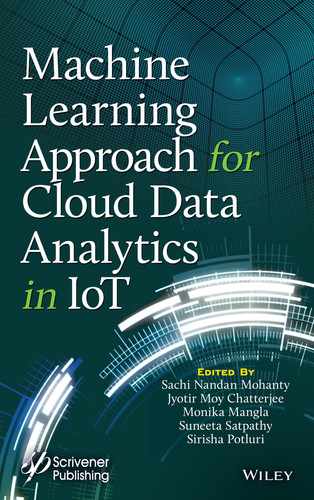Preface
Sustainable computing paradigms like cloud and fog are capable of handling issues related to performance, storage and processing, maintenance, security, efficiency, integration, cost, energy and latency in an expeditious manner. According to statistics, billions of connected IoT devices will be producing enormous amounts of real-time data in the coming days. In order to expedite decision-making involved in the complex computation and processing of collected data, these devices are connected to the cloud or fog environment. Since machine learning as a service provides the best support in business intelligence, organizations have been making significant investments in the creation of the first artificial intelligence services. The abundant research occurring all around the world has resulted in a wide range of advancements being reported on computing platforms. This book elucidates some of the best practices and their respective outcomes in cloud and fog computing environments. The practices, technologies and innovations of business intelligence employed to make expeditious decisions are encouraged as a part of this area of research.
This book focuses on various research issues related to big data storage and analysis, large-scale data processing, knowledge discovery and knowledge management, computational intelligence, data security and privacy, data representation and visualization and data analytics. The featured technology presented herein optimizes various industry processes using business intelligence in engineering and technology. Light is also shed on cloud-based embedded software development practices to integrate complex machines so as to increase productivity and reduce operational cost. The various practices of data science and analytics which are used in all sectors to understand big data and analyze massive data patterns are also essential sections of this book.
Chapter 1 focuses on the use of large amounts of information that enable a computer to carry out a non-definitive analysis based on project understanding. Chapter 2 explains an approach to establish an interactive network of cognitively intervening domains of cyber security services to the computational specifications of the Internet of Things (IoT). Various approaches for predictive data analytics are briefly introduced in Chapter 3; and Chapter 4 covers details of cloud evolution, adaptability and key emerging trends of cloud computing. Chapter 5 discusses the security challenges as well as methods used for tackling those challenges along with their respective advantages and disadvantages for protecting data when using cloud storage. Chapter 6 methodically audits the security needs, the assault vectors and the current security responses for IoT systems and also addresses insights into current machine learning solutions for solving various security issues in IoT systems and a few future cryptographic cloud analysis headlines. In Chapter 7, the RSA algorithm is implemented as homomorphic encryption and the authors attempt to reduce its time complexity by implementing the homomorphism RSA. Chapter 8 discusses the challenges of using smart city technology and IoT networks via CR and EH technologies. In Chapter 9, a study of the four well-known heuristic task scheduling algorithms of HEFT, CPOP, ALAP and PETS is presented along with their comparative study based on performance metrics such as schedule length, speedup, efficiency, resource utilization and cost. Chapter 10 overviews the potential applications of cloud computing in smart working systems and case studies; and a study is presented in Chapter 11 on the dual sink approach using clustering in body area network (DSCB). Chapter 12 reviews the comprehensive literature on green cloud computing and exposes the research gaps in this field that have a lot of research potential for future exploration. In Chapter 13, a system is proposed which identifies the disease, classifies it, and responds according to the type of disease identified and also describes the preventive measures using deep learning. Chapter 14 aims to predict the five sectors—the pharmaceutical, banking, fast-moving consumer goods, power and automobile sectors— using linear regression, recurrent neural network (RNN) and long short-term memory (LSTM) units. Chapter 15 analyzes the Aadhaar dataset and draws meaningful insights from the same that will surely ensure a fruitful result and facilitate smoother conduct of the upcoming NPR. Chapter 16 first outlines the current block chain techniques and consortium block chain framework, and after that considers the application of blockchain with cellular 5G network, Big Data, IoT, and mobile edge computing. Chapter 17 shows how various advanced machine learning methods are used for different application in real life scenario. Chapter 18 explores the anthropomorphic gamifying elements, mostly on how it can be implemented in a blockchain-enabled transitional healthcare system in a more lucrative manner.
Sachi Nandan Mohanty, India
Jyotir Moy Chatterjee, Nepal
Monika Mangla, India
SuneetaSatpathy, India
Sirisha Potluri, India
May 2021
